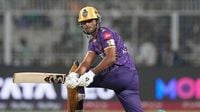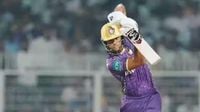The Kolkata Knight Riders (KKR) have established themselves as a formidable franchise in the Indian Premier League (IPL), boasting multiple trophy wins. However, a concerning pattern has emerged regarding their team management strategy, particularly their tendency to position promising batsmen far below their optimal batting positions. This approach has raised questions about player development and overall team performance.
In the latest match against the Gujarat Titans (GT), KKR's batting order decisions were once again under scrutiny. The franchise sent young Angkrish Raghuvanshi to bat at number nine, arriving after the fall of the seventh wicket with the team struggling at 119/7 in the 17th over. This decision defies logical cricket thinking, as Raghuvanshi has shown promise batting at positions three and four, where he averages 23.29 and 45.00 respectively with strike rates above 145.
Raghuvanshi's situation is not an isolated incident. The franchise has a history of mismanaging batting order positions, which has potentially hampered the development of their players. The case of Suryakumar Yadav (SKY) serves as a prime example. During his time with KKR, Yadav was frequently used in non-optimal positions, despite being one of the world's premier T20 batsmen. His batting statistics at KKR reveal a stark contrast to his success after moving to the Mumbai Indians (MI). At KKR, he averaged only 19.5 at No. 4, while at MI, he has thrived, averaging 42.52 at the same position.
Shubman Gill's experience with KKR further highlights the issue of batting order mismanagement. Although he is naturally an opening batsman, KKR experimented with him throughout the order, often batting him down the lineup. This inconsistency disrupted his rhythm, and his average improved significantly after moving to the Gujarat Titans, where he has averaged 43.78 as an opener.
In the recent clash against GT, KKR faced a 39-run defeat after being set a target of 199 runs. The team's batting performance was lackluster, with Venkatesh Iyer scoring a mere 14 runs off 19 balls and Ajinkya Rahane, the captain, managing 50 runs off 36 balls. The decision to send Raghuvanshi to bat at No. 9, while keeping star all-rounder Andre Russell on the bench, left many questioning KKR's tactical choices. Russell scored 21 runs off 15 balls when he finally got the chance to bat, while Raghuvanshi finished with an unbeaten 27 runs off 13 deliveries.
Pragyan Ojha, a former player and commentator, expressed his surprise at KKR's lack of intent and their batting order decisions. He stated, "There was no intent from the players. A lot of mistakes were made in the bowling department. Batting is lacking firepower. Angkrish Raghuvanshi should bat in the top order as this is where he can contribute for the team." Ojha's comments reflect a growing concern among fans and analysts regarding KKR's approach to player utilization.
After the match, Rahane acknowledged the need for a more aggressive mindset among players. He stated, "This format is about being brave as a batter. You can’t think too much about the past, just learn from the mistakes and take your chances." While he praised Raghuvanshi's performance, he admitted that the match situation warranted other batters to bat higher up the order. However, this strategy backfired as the middle-order batters failed to capitalize on their opportunities, leaving KKR in a precarious position.
As it stands, KKR finds itself in a tough spot in the IPL standings, currently sitting seventh with just three wins out of eight matches. Meanwhile, the Gujarat Titans are at the top of the table with 12 points from eight contests, showcasing the effectiveness of their batting order strategy. The contrasting fortunes of both teams highlight the importance of optimal player placement in achieving success.
Looking ahead, KKR must reconsider their batting order management if they hope to maximize both player potential and team performance. The evidence from Yadav and Gill's career trajectories after leaving KKR suggests that allowing batsmen to play in their natural positions yields superior results. With Angkrish Raghuvanshi showing significant promise, KKR faces a pivotal choice: learn from past missteps and give him consistent opportunities in the top-middle order or risk watching another potential star thrive elsewhere after departing their ranks.
The statistics and patterns are clear—KKR's batting order management requires serious reconsideration. The franchise must prioritize long-term player development over immediate tactical considerations if they aim to reclaim their status as a dominant force in the IPL.






